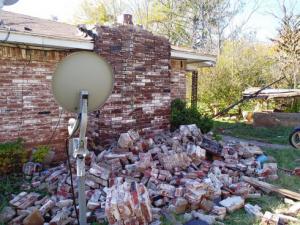Man-made earthquakePreventing human-caused, fracking-related earthquakes
The 31 May 2014 earthquake that rumbled below Colorado’s eastern plains surprised both local residents and local seismologists. The earthquake happened in an area that had seen no seismic activity in at least four decades. It was likely caused by the injection of industrial wastewater deep underground. New research shows actions taken by drillers and regulators can lessen risk in the case of earthquakes likely caused by the injection of industrial wastewater deep underground.

Damage from an earthquake in Oklahoma // Source: theconversation.com
New research from the U.S. Geological Survey and the University of Colorado shows actions taken by drillers and regulators can lessen risk in the case of earthquakes likely caused by the injection of industrial wastewater deep underground.
While the earthquake that rumbled below Colorado’s eastern plains on 31 May 2014 did no major damage, its occurrence surprised both Greeley residents and local seismologists. To some Greeley residents, the magnitude 3.2 earthquake felt like a large truck hitting the house.
USGS says that the earthquake happened in an area that had seen no seismic activity in at least four decades, according to a new analysis by a team of Colorado researchers. It was likely caused by the injection of industrial wastewater deep underground — and, the team concluded, quick action taken by scientists, regulators and industry may have reduced the risk of larger quakes in the area.
“We were surprised to observe an earthquake right in our backyard, and we knew we needed to know more, so we quickly mobilized seismic monitoring equipment,” said Will Yeck, lead author of the study. “As it turned out, our findings were not just scientifically interesting. By sharing our observations with others in real time, we were able to help inform the decisions made to mitigate these earthquakes. It was extremely rewarding to see our scientific observations have a direct and immediate impact.”
Yeck, then finishing up his Ph.D. in geophysics at the University of Colorado Boulder, and now a researcher with the USGS, worked with a team of researchers that included his Ph.D. advisor Anne Sheehan, a professor and CIRES Fellow, two other graduate students and a USGS colleague. Their work appears in the July-August issue of Seismological Research Letters.
A few minutes after 10 p.m. the night of the earthquake, Sheehan also received an email from a neighbor who had felt an earthquake at her home in Boulder. The neighbor quickly looked up the initial details through a USGS website, and relayed them to Sheehan. It looked like the earthquake was centered in the heart of oil and gas country in Weld County, where drillers sometimes disposed of wastewater deep underground — an activity now known to sometimes trigger earthquakes.
In many homes near the earthquake’s epicenter, furniture shifted in rooms. Bricks fell off at least one chimney.
“The next day was very busy,” said Sheehan.
